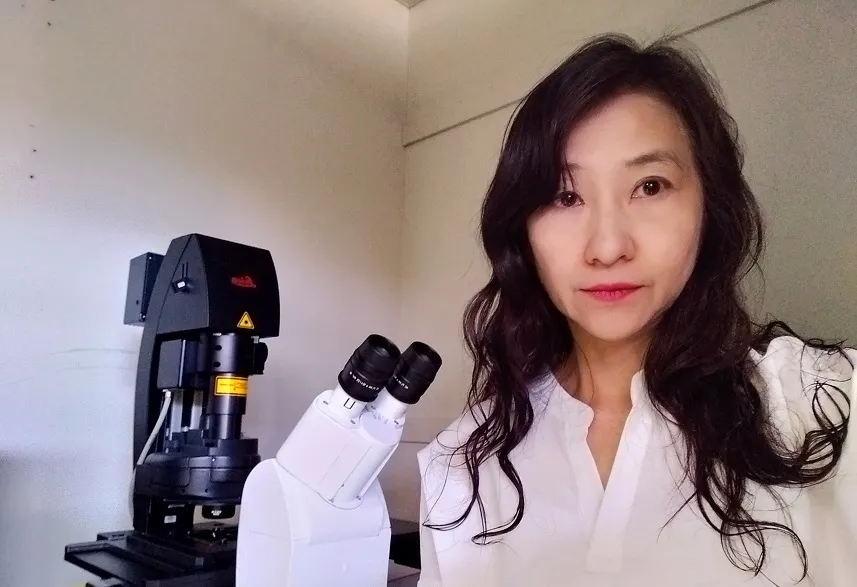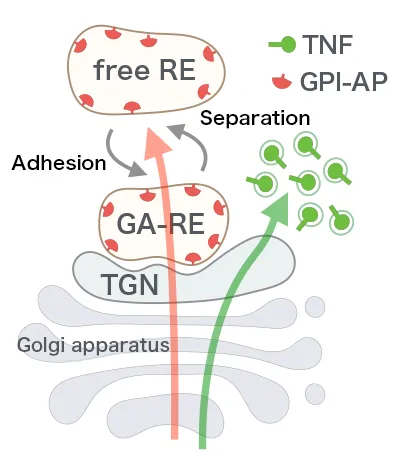Interview of Professor Akiko SATOH
Unravelling “Adhesion and Separation” Transport System between Golgi and endosome Found in a Wide Range of Species

| Program | JST Strategic Basic Research Programs (CREST) | Researchers selected in the FY | 2022 |
|---|
Exploring the Marvels of the Golgi Apparatus: Ensuring Precise Protein Delivery
I have investigated membrane traffic since I was an undergraduate, around 30 years now. Membrane traffic refers to the movement of essential molecules such as proteins and lipids between multiple cell organelles via membranes. The significance of this molecular mechanism for humans and other higher organisms with eukaryotic cells earned three researchers the 2013 Nobel Prize in Physiology or Medicine for their contributions to elucidating its intricacies.
My research focuses primarily on the Golgi apparatus, an organelle that plays a central role in membrane traffic. The Golgi apparatus receives proteins synthesized by ribosomes on the endoplasmic reticulum membrane, concentrates and sorts them, and accurately delivers them to their intended destinations, both inside or outside the cell. Proteins play essential roles in various cellular functions, and the Golgi apparatus serves as the central hub for collecting and delivering these proteins. It is well-established that dysfunction of the Golgi apparatus can lead to various diseases. Our research project, selected for the Japan Science and Technology Agency’s CREST program for strategic basic research, focuses on the Golgi apparatus, particularly on understanding molecular events occurring at the trans-Golgi network (TGN), which locates the end of the Golgi apparatus. This project aims to elucidate the molecular mechanisms underlying TGN function, shedding light on essential processes within the Golgi apparatus.
From Drosophila to Mammalian Cells
Since the very beginning of my research, I have focused on investigating the photoreceptor cells of Drosophila (a kind of fly) to unravel the mechanism of the TGN. To understand how proteins are sorted and transported from the TGN, we setup experiments enabling us to synchronously initiate protein transport from the endoplasmic reticulum (ER) and observe the flow of this transport process. Just before my joining to the lab, my undergraduate advisor had demonstrated that light could be used to initiate transport of the photosensitive protein rhodopsin in Drosophila photoreceptor cells. Thus, we embarked on establishing a transport initiation experiment method based on this discovery. The relative ease of generating mutants in Drosophila, coupled with the opportunity for genetic manipulation, led me to commence my research journey into membrane transport using Drosophila photoreceptor cells. I continued with this research during my studying in the US, and after establishing my own laboratory, I further developed it into a unique system which I have continued to refine over the years. The challenge to conducting live imaging, however, was the small size of both the cells and the Golgi apparatus, as well as the short transport distance compared to mammals and other higher organisms.
Over the past decade or so, there has been a dramatic shift in the landscape of research. The advent of genome editing technology has simplified the modification of mammalian cells, while advancements in microscopy have revolutionized my research by providing much more sophisticated tools for direct, real-time observation of Golgi apparatus transport in mammalian cells. In this CREST project, we are also dedicated to shed light on the mechanism of TGN using human-derived cells.
Unraveling the Enigma of Sequential Adhesion and Separation between Golgi Apparatuses and endosomes
Before I delve into the details of our CREST project, allow me to share the pivotal discovery that served as its foundation. In Drosophila photoreceptor cells, we uncovered a remarkable phenomenon: recycling endosomes (REs) exhibited a repetitive pattern of adherence to and detachment from TGNs. Endosome is a general term for organelles responsible for regulating the intracellular transport of molecules originating from the plasma membrane or extracellular environment. Among them, REs play a crucial role in the intracellular recycling pathway by facilitating the recycle of molecules, such as receptors and membrane proteins, from endosomes back to the plasma membrane. It was widely believed that endosome function was unrelated to the sorting and delivery of newly synthesized proteins by the Golgi apparatus. However, our findings challenged this notion, suggesting that endosomes and Golgi apparatuses might indeed engage in membrane traffic through repeated adhesion and separation processes. This revelation unveiled a previously unknown dimension to the coordination between these organelles in intracellular protein transport.
Membrane trafficking, also known as “intracellular vesicular trafficking,” involves encapsulating cargo proteins and lipids within vesicles and transporting them to their designated destinations within the cell. Previously, the transport of molecules between organelles was primarily explained by intracellular vesicular trafficking. However, our discovery revealed the possibility of another pathway, in which Golgi apparatuses and endosomes exchange molecules through direct interaction. Although the molecular mechanism governing trafficking between Golgi apparatuses and endosomes is not yet fully understood, it is conceivable that membranes fuse at sites of adhesion, creating pores between the two that allows molecules to be transferred. We refer to this phenomenon as “transport through adhesion,” and we hypothesize that it represents a novel mode of membrane trafficking. Previous experiments have demonstrated that the adhesion and separation of Golgi apparatus and endosomes are observable not only in drosophila but also in the sea urchin (an echinoderm) and mammalian cells. This suggests that transport through adhesion is a fundamental mechanism present across a wide range of organisms.

Two cargo proteins synthesized in the endoplasmic reticulum, GPI-AP and TNF, are delivered to the Golgi apparatus and reach the TGN at the apparatus’s terminus. REs repeatedly adhere to and separate from TGN. GPI-AP is incorporated into the adhering RE (Golgi-attached RE or “GA-RE”), and the GA-RE separates from the TGN to become a free RE and is transported from the Golgi apparatus to the plasma membrane. In contrast, TNF does not enter the GA-RE but is instead transported directly from the TGN to the plasma membrane.
Pioneering New Understanding of Vital Phenomena
In our CREST project, we aim to elucidate the molecular mechanisms of direct contact transport between TGNs and endosomes using human-derived cells, employing live imaging observation and 3D electron microscopy.
What kind of proteins exist in the area where Golgi apparatuses and endosomes adhere? What kind of structures do they form? What kind of mechanisms are used to sort and pass on the cargo proteins? To unlock these mysteries, we put together a CREST project team comprising diverse members from across Japan, each bringing cutting-edge skills to the table. Our team includes experts in high-speed super-resolution live imaging and 3D electron microscopy, as well as developers specializing in organic synthesis and super-resolution microscopy developers. These collective skills are being brought to bear in our research. Whatever skills we lack are complemented through collaborations with other CREST teams and by actively utilizeing Japanese research support programs. In this manner, we are dedicated to constructing a comprehensive understanding of the mechanisms underlying transport through adhesion.
